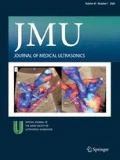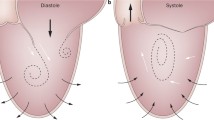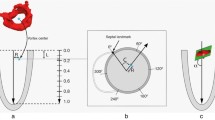Abstract
Purpose
From the correlation between the blood flow dynamics and wall dynamics in the left ventriocle (LV) analyzed using echo-dynamography, the ejection mechanisms and role of the intra-ventricular vortex in the LV were elucidated in detail during the pre-ejection transitional period (pre-ETP), the very short period preceding LV ejection.
Methods
The study included 10 healthy volunteers. Flow structure was analyzed using echo-dynamography, and LV wall dynamics were measured using both high-frame-rate two-dimensional echocardiography and a phase difference tracking method we developed.
Results
A large accelerated vortex occurred at the central basal area of the LV during this period. The main flow axis velocity line of the LV showed a linearly increasing pattern. The slope of the velocity pattern reflected the deformity of the flow route induced by LV contraction during the pre-ETP. The centrifugal force of the vortex at its junction with the main outflow created a stepwise increase of about 50% of the ejection velocity.
Conclusion
Ejection of blood from the LV was accomplished by the extruding action of the ventricular wall and the centrifugal force of the accelerated vortex during this period. During ejection, acceralated outflow was considered to create a spiral flow in the aorta with help from the spherical structure of the Valsalva sinus.






Similar content being viewed by others
References
Kilner PJ, Yang GZ, Mohiaddin RH, et al. Helical and retrograde secondary flow pattern in th aortic arch studied by three-directional magnetic resonance velocity mapping. Circulation. 1993;88:2235–47.
Tanaka M, Sakamoto T, Sugawara S, et al. Spiral systolic blood flow in the ascending aorta and aortic arch analyzed by echo-dynamography. J Cardiol. 2010;56:97–110.
Braunwald E, Sonnenblick EH, Ross J Jr. Contraction of the normal heart. In: Braunwald E, editor. Heart disease. 2nd ed. Philadelphia: WB Saunders Co.; 1984. p. 409–46.
Rushmer RF. Functional anatomy and control of the heart. In: Rushmer RF, editor. Cardiovascular dynamics. 4th ed. Philadelphia: WB Sounders Co.; 1976. p. 76–131.
Ishida N, Takishima T (1992) Cardiodynamics and its clinical application. In: Ishida N, Takishima T (eds) 2nd ed. Bunkodo Co., Tokyo. p 1–214.
Arheden H, Stahlberg F (2013) Blood flow measurement. MRI and CT of the cardiovascular system. In: Higgins CB, Roos A., Lippincott, et al. (eds) 3rd edn. Philadelphia. p 75–92.
Tanaka M, Miyatake K, Kanbe T, et al. (1988) Application of the ultrasonic Doppler method. In: Jpn. Soci. Ultras. Med. (eds) Diagnostic Ultrasound, principles and clinical applications. Igaku-Shoin Ltd., Tokyo. p 167–230.
Tanaka M. Usefulness of ultrasonic imaging in the medical field. In: Shimizu H, Chubachi N, Kushibiki J, editors. Acoustical imaging. New York: Plenum Press; 1989. p. 453–66.
Tanaka M (1998) Historical perspective of the development of echocardiography and medical ultrasound. In: Schneider SC, Levy M, McAvoy BR (eds) Proceedings of IEEE ultrasonics symposium. IEEE Inc, New York. p. 1517–24.
Tanaka M, Sakamoto T, Sugawara S, et al. A new concept of the contraction-extension property of the left ventricular myocardium. J Cardiol. 2014;63:313–9.
Tanaka M, Sakamoto T, Sugawara S, et al. Blood flow structure and dynamics, and ejection mechanism in the left ventricle: analyzing using echo-dynamography. J Cardiol. 2008;52:86–101.
Tanaka M, Sakamoto T, Sugawara S, et al. Physiological basis and clinical significance of left ventricular suction using echo-dynamography. J Cardiol. 2011;58:232–44.
Tanaka M, Sakamoto T, Katahira Y, et al. Non-uniform distribution of the contraction/extension (C-E) in the left ventricular myocardium related to the myocardial function. J Cardiol. 2014;64:401–8.
Tanaka M, Sakamoto T, Sugawara S, et al. Deformability of the pulsating left ventricular wall: a new aspect elucidated by high resolution ultrasonic methods. J Cardiol. 2017;69:462–70.
Ohtsuki S, Tanaka M, Okujima M. A method of flow vector mapping deduced Doppler data on scanned plane. In: Shimizu H, Chubachi N, Kushibiki J, editors. Acoustic imaging. New York: Plenum Press; 1989. p. 467–72.
Ohtsuki S, Tanaka M. Flow function for streamlines representative of the flow on a plane in three-dimensional flow. J Visual Soc Jap. 1998;18:136–40.
Ohtsuki S, Tanaka M. Doppler pressure field deduced from the Doppler velocity field in an observation plane in a fluid. Ultrasound Med Biol. 2003;29:1431–8.
Ohtsuki S, Tanaka M. The flow velocity distribution from the Doppler information on a plane in three dimensional flow. J Vis. 2006;9:69–82.
Tanaka M, Nitta S, Yamamoto A, et al. Development and application of non-invasive method for the evaluation of cardiac function, Quantifying intracardiac blood flow. Asian Med J. 1994;37:283–6.
Tanaka M, Nitta S, Yamamoto A, et al. Development and application of non-invasive methods for the evaluation of cardiac function: measuring cardiac function. Asian Med J. 1994;37:397–400.
Tanaka M, Yamamoto A, Endo N, et al. (1992) Evaluation of the behavior of blood flow in heart chambers by means of stream line distribution method. In: Visualization Soc Jap editor. Atlas of visualization. Pergamon Press, Oxford. p. 205–219.
Hino M. Introduction to fluid mechanics. In: Hino M, editor. Fluid dynamics. Tokyo: Asakura Book Co.; 2002. p. 28–362.
Tanaka M, Nitta S, Yamamoto A, et al. Development and application of non-invasive method for the evaluation of cardiac function, Visualization of pressure changes in heart chambers. Asian Med J. 1994;37:341–4.
Yoshiara H, Hasegawa H, Kanai H, et al. Ultrasonic imaging of propagation of contraction and relaxation in heart walls at high temporal resolution. Jpn J Appl Phys. 2007;46:4889–96.
Tanaka M, Kanai H, Sato M, et al. Measurement of the moving speed of local myocardial tissue by using the phase difference tracking method and its clinical significance. J Cardiol. 1996;28:163.
Kanai H, Hasegawa H, Chubachi N, et al. Noninvasive evaluation of local myocardial thickening and its color-coded imaging. IEEE Trans Ultrason Feroelect Freq Contr. 1997;44:752–68.
Kanai H, Hasegawa H, Chubachi N, et al. Non-invasive evaluation of spatial distribution of local instantaneous strain energy in heart wall. In: Lees S, Ferrari LA, editors. Acoustic imaging. New York: Plenum Press; 1997. p. 187–92.
Tanaka M. Ultrasonic diagnosis of the heart. Tokyo: Medical Electro Times Ltd; 1978. p. 118–28.
Ueda H, Kaito G, Sakamoto T. Clinical Phonocardiography-Auscultation of the Heart and Phonocardiography. Tokyo: Medical Electro Times Ltd; 1978. p. s100–s239.
Author information
Authors and Affiliations
Corresponding author
Ethics declarations
Conflict of interest
There are no financial or other relations that could lead to a conflict of interest.
Ethical aprroval
All procedures followed were in accordance with the standards of the Ethics Committee for Human Research (institutional and national) and with the Helsinki Declaration of 1975, as revised in 2008.
Additional information
Publisher's Note
Springer Nature remains neutral with regard to jurisdictional claims in published maps and institutional affiliations.
About this article
Cite this article
Tanaka, M., Sakamoto, T., Saijo, Y. et al. Role of intra-ventricular vortex in left ventricular ejection elucidated by echo-dynamography. J Med Ultrasonics 46, 413–423 (2019). https://doi.org/10.1007/s10396-019-00943-5
Received:
Accepted:
Published:
Issue Date:
DOI: https://doi.org/10.1007/s10396-019-00943-5




